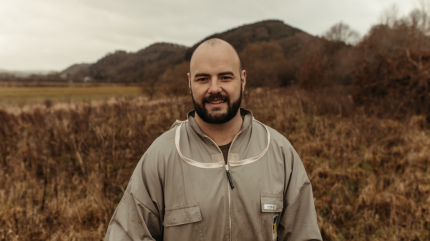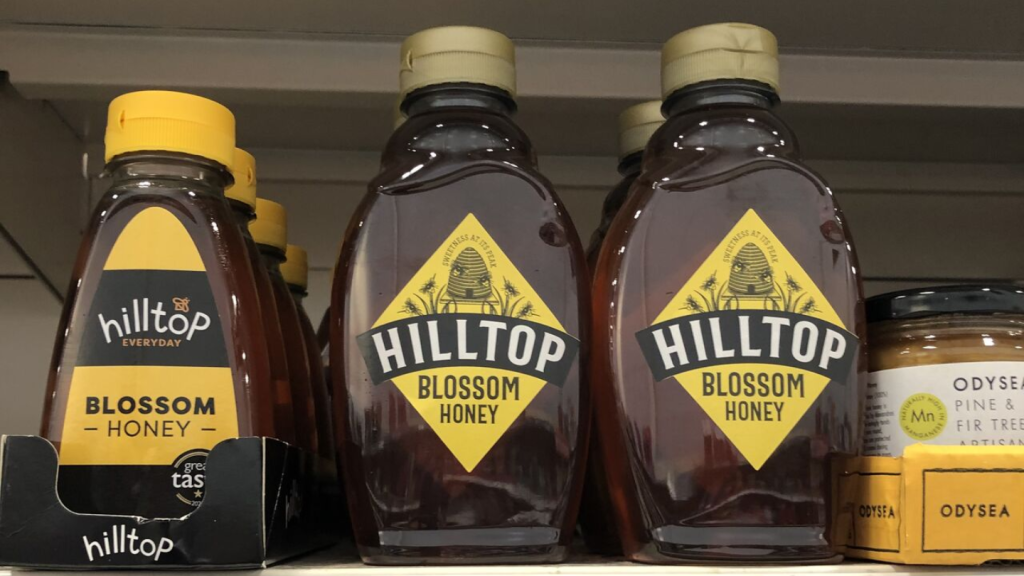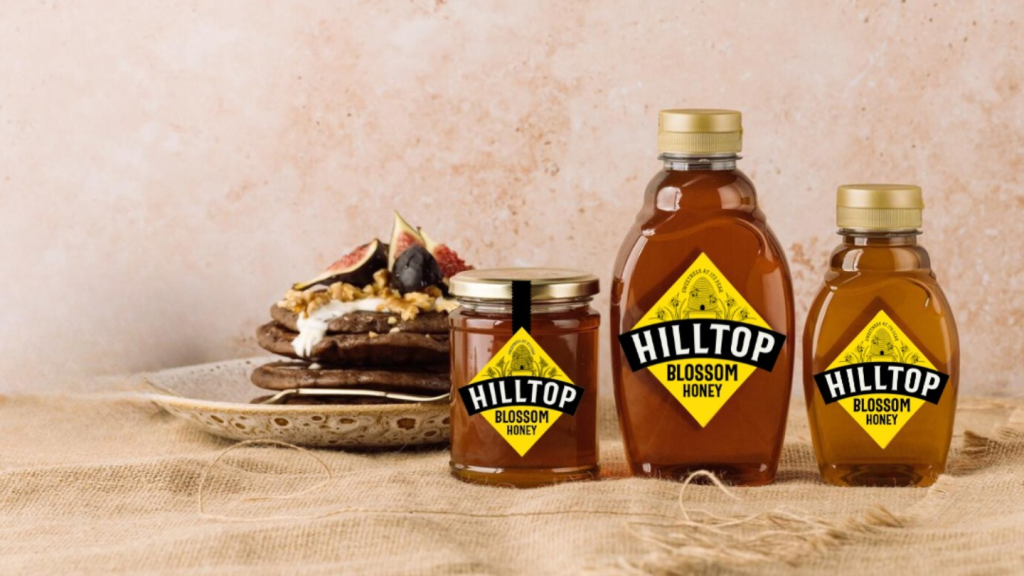
Hilltop Honey is a UK-based honey manufacturer and packer that claims to be the second-largest honey producer in the UK by volume and the fourth-largest in Europe. The honey producer employs circa 130 people and its plant in Newtown, Wales has a processing capacity of around 30,000 tonnes of honey a year.
Last month, the company received £10m ($13.2m) in funding from banking group Santander with an eye towards expanding globally, looking specifically at the US, Australia and the Middle East.
Just Food sat down with founder Scott Davies to talk through Hilltop’s plans with the fresh funding and the “inherently flawed” authenticity problems within the industry.
Henry Mathieu (HM): What are the main priorities with the new investment from Santander?
Scott Davies (SD): We were looking for a bank that would support our growth. Santander, when you actually look at their market cap, they’re twice the size of Barclays. They’ve got global reach, all these things in different countries, so it was a huge change for us.
The idea is that they were hungry for growth and could help us expand into the markets we wanted to, as simple as that. The UK is great. We’re doing things great in the UK and things are working fine. But there’s only so many people you can sell to in the UK, so naturally you look abroad.
Basically, I’ve dabbled with export for ten of my 13 years at Hilltop. The problem is that we were only dabbling. We weren’t really taking it all that seriously. God knows it’s hard enough to launch a brand successfully into your own country when you speak the language and you know the culture. Doing it abroad is just doubly as hard.

US Tariffs are shifting - will you react or anticipate?
Don’t let policy changes catch you off guard. Stay proactive with real-time data and expert analysis.
By GlobalDataNow we’ve taken ourselves a lot more serious in that stance. We want to push America mainly, and we’ve also got some pretty good wins at the moment in Australia randomly.
HM: Is Hilltop Honey present in the US and Australia?
SD: No, so Australia, we’re just putting the last finishing touches together for that launch, which seems really promising. In America, we’ve just done tiny bits in New York but now we’re going to do a launch through Amazon Marketplace over there and Walmart, and then start picking up conversations with retailers pretty much immediately after that.
HM: What was it about the US and Australia that prompted you to target those countries?
SD: The US is the largest importer of honey in the world by an absolute mile. The UK imports around 45,000 tonnes of honey. America is up there with around 300,000 tonnes of honey. It’s a monstrous market. It needs imports to keep its domestic market alive. It’s an attractive market for basically any honey packer in the world.
Because of the trade deals done with Australia and the UK, it’s become a little bit easier over there as well but really it shows my entrepreneurial side a little bit. We have an employee who decided to go travelling. He ended up in Australia for a little while. I said to him why don’t you have a stab at trying to grow Hilltop in Australia? And he’s going, well, why not? Around three months later, we’ve got meetings with Coles and all sorts. That was just more of an opportunistic moment, really, rather than a well-thought-out plan. America is our main focus and that’s where the strategy really lies.
HM: Is the US honey market more saturated in terms of brands due to demand?
SD: There’s not what we believe are great brand players, even if there’s a couple of decent brands, but after it’s quite fragmented. Obviously, they’ve got the loyalty to American honey and that’s fine but we believe there’s no one doing a great job on European honey.

I feel there’s a massive education piece that needs to happen over in America, too. So, yes, there’s always going to be a fight in any market you go into but it feels like we’ve got the right firepower being backed by our businesses we’ve got in the UK to really give it a push.
HM: Do you only produce Hilltop branded honey or do you make own-label as well?
SD: Yeah, we’re manufacturers, so we do both. This is the hardship that honey has: how does it create a USP for itself in these brands? Most people think honey is just honey and it’s a bronzy-coloured liquid in a squeezy bottle and basically you can buy it as cheap as you want. How we compete with supermarket and own-label is the obvious go-to: the quality.
We put different types of honey in our blend. We get different honey from different countries and make it taste nicer, make the crystallisation performance better. We’re doing a lot of due diligence on our supply chain as well, and we’re going further into the authenticity piece. That’s probably the biggest thing that honey has around it right now: authenticity.
It’s a real political reason why it’s getting worse and worse. But Europe has certain ways of looking at it. So does America, so does Asia. Everybody has different ways of looking at it but no one’s got a true, tested way of measuring authentic honey or not. The biggest challenge, I think, for us is how we bring about people to believe that our honey is real.
But the problem is, just being honest, how much of the market actually do see it like that? So we maybe are pandering into a small part of the market that really know their honey.
HM: Can you expand on some of the authenticity challenges?
SD: The main laboratory is a control global honey testing site in Germany. They have a certain way of looking at honey and they developed tests that, on the face of it, looked like really good tests but the problem is that they’re basically tests on databases. So, if you’re going to run tests against the database for proof that honey is real, right? What they do is put all these honeys that they know to be real on this database and it basically gives you a DNA fingerprint of a honey from the middle of Wales, for example.
So, they’ll take 100 samples of honey for the middle of Wales and they’ll all typically make up a certain level of pollen, a certain number of different types of flowers, this type of F/G [fructose to glucose] ratio and that’s Welsh honey. If you put something in there from South America that’s got watermelon pollen in it and some other tree pollen in it that doesn’t exist in mid-Wales, you’ll say that’s not Welsh honey, right? That’s it in its basic simplicity.
Now, the problem is, if you are the custodian of that database, you are now the guy that just dictates what’s real and what’s not. They’re not scientifically back to where they started the study.
Also, the problem with the test is: how do you know what honeys are real before you put them on the database? Because this test didn’t exist, right? So, you must have validated all these honeys over here to put them on a database, surely, right? They haven’t done that work, so it’s inherently flawed. But they’re so far in because it’s cost these labs so much money that they’re trying to push it down readers’ throats and then release it to the press.
HM: How does Hilltop ensure its authenticity?
SD: There is no universal way of identifying fake honey. Every continent has a different version of what is real and what is fake. The question you ask yourself is: how do you go about doing it? We did go to the source. I’ve been into the outback of outer Mongolia and beyond, around the top end of China, I’ve been down into New Zealand, all around South America, Tanzania, all through Africa. You go to the places, you audit them, you look at their factories, you go back to their beehives, you go back to the beekeeper collectors, and you just look at where the gaps in the supply chain are that could result in somebody adulterating that honey. Then you validate through that.
There is no universal way of identifying fake honey. Every continent has a different version of what is real and what is fake.
But the German test labs and their way of authenticating honey is by testing alone. They don’t go like we’ve gone to trace it all. We double down, we do tests and we do the supply piece and that’s how we feel confident about it.
As an industry, we’re dying for something to come along and give us a global standard but, because of the political tensions, because there’s such a commercial angle for this, I don’t think anybody’s ever going to get there, which is a shame, so all you can do is stick in your own lane and do your own audits.
HM: Where does Hilltop source its best-selling honey? Is it from the UK?
SD: Ours is a South American and Asian blend of honey to hit the price-point and the flavour typical for the UK consumer. I started off with British honey and my own beehives and then expanded into more British beekeepers. We still sell British honey, of course we do, but, unfortunately, what I tried to explain to British beekeepers is that the UK consumer doesn’t want to buy it, so that’s why I can’t sell any more of it.

It’s weird because you get this perception of everyone wanting to buy British but you go and put it on the shelf, and it’s £7 per jar compared to £1.50 per jar. People then are not that bothered by it and they stop buying it. There is British honey sold and I would love to sell more of it but the question is: how do you get people to care enough to spend four times the price on it?
It’s a nice-tasting honey, don’t get me wrong, but is it worth four times the price? That’s the problem. There’s no health benefits playing to it, like the Manuka honey and stuff. So, we’re forever on a quest to bring the best honey to the market. I really want to sell more of the good stuff nut it’s a huge education piece with the consumer that’s going to take years.
HM: As you look to educate consumers to spend more on honey, what other consumer trends are driving sales?
SD: Basically, you’ve got the retail all fighting each other and it’s a race to the bottom. You’ve got certain retailers who care so much about something and certain retailers who care a bit less about something, but they all want the same price. They all want to fight each other on the price but they’re trying to match these different specs. Ultimately, the price is being driven out of honey because it’s seen as a staple in the basket. It’s getting sold for prices that people can’t even believe.
I’m not going to reveal tactics, retail, pricing or anything else like that, but ultimately, what I’m trying to say is, if the own-label honey keeps getting cheaper, not by design, just because that’s what they’re doing with it and it’s out of our control, then it makes it harder to sell higher-value honey. That gap is just getting further and further away from what the base was.
You’ve got the retail all fighting each other and it’s a race to the bottom
So really, the consumer trend is that they’re not seeing enough value in the stuff that’s five times the price unless it’s got a superior health claim to it, such as Manuka honey. We’ve got this weird middle ground where you’ve got a super-premium honey, which is Manuka, and people are willing to spend on it now and then you got the absolute cheapest of the cheap honey.
The middle ground is almost like a no man’s land at the moment. The problem I have is, if I had my way, I’d obviously launch a load more different types of honeys, like your lavender, eucalyptus, orange blossom, having all sorts of types. But you are not going to sell a high volume of lavender honey or eucalyptus honey.
Unfortunately, it’s just not at the levels that they need. You’re still going to sell some of it. And it sells, in my opinion, quite well, and it’s good for honey. It’s good for the industry but that war that’s happening at the minute doesn’t create a healthy environment for education in honey.



